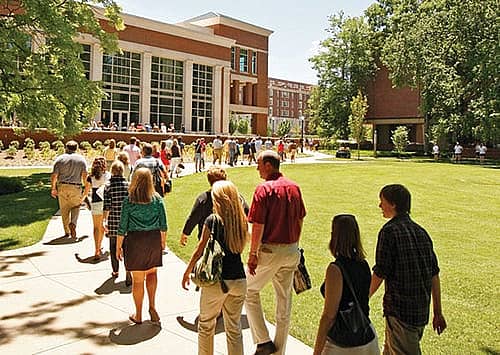Visiting college campuses is often the first step students take in taking the abstract concept of college and translating it to the real world. These initial visits serve as an introduction to college life and an opportunity for students to start building the framework they will use to make important decisions later in the process. While this first step can seem daunting, it doesn’t have to be. By considering the following factors when selecting colleges to visit this spring, students can maximize the benefit of each visit.
Schedule your visit when students are on campus–can you picture it?
Seeing students on campus allows prospective students to get a sense of the culture, community, and atmosphere of the college. While it isn’t always possible to visit while class is in session, students and families should prioritize doing so whenever possible.There is much to learn simply from observing students on campus; where they choose to study, where they spend their free time, and how they interact with one another and the faculty allows a glimpse into the social norms, values, and vibe on campus. It’s also beneficial for students to ask themselves, can I see myself here? Sometimes the answer will be clear, and other times, a student may need to revisit the campus later in the process to answer that question.
Attend information sessions and guided tours–make it official!
While it may be appealing to casually take in a college campus, it is often not as effective or comprehensive as attending an organized info session and (often) student-led tour. Information sessions are a great way to learn more about the academic offerings, campus life, and admissions process of a college or university. Student-led tours provide the opportunity for students and families to hear directly from current students who are engaged in and knowledgeable about life on campus. Official visits also serve as a way for students to demonstrate interest in a particular college. Even when attending events like college representative visits at school, local presentations, and college fairs, be sure to complete the information card to let college admissions offices know you were there.
Visit a range of colleges–contrast is key!
Seeing a variety of types of colleges is important, especially early on. Students should consider seeing both liberal arts colleges and research universities. Liberal arts colleges focus on teaching problem solving skills to students while encouraging critical thinking with an emphasis on communication. Research universities allow students to learn from and work with professors who are engaged in completing and publishing research in their fields. It’s also important to see colleges that exist in different locations, such as urban, suburban, and rural areas, as well as to consider colleges both closer to home and farther away. Size is also important to factor in when scheduling your visits; include small (under 5,000 students), medium (between 5,000-15,000), and larger sized colleges (over 15,000) to get a sense of what feels “just right” to you.
Keep an open mind–students and parents.
Given the incredible number of college options available to students, it can be tempting to rule things out right away; however, at this point in the process, it’s important to remain flexible in your thinking. This goes for parents too. You know your child and you may assume that you know what they will like or where they will do well. Resist the temptation to make statements or share opinions about colleges at this stage. These initial visits are an important developmental step for students to begin to craft their own ideas about what a best fit college looks like. Stay curious about the colleges your student expresses interest in and ask questions about their impressions before and after a visit.


